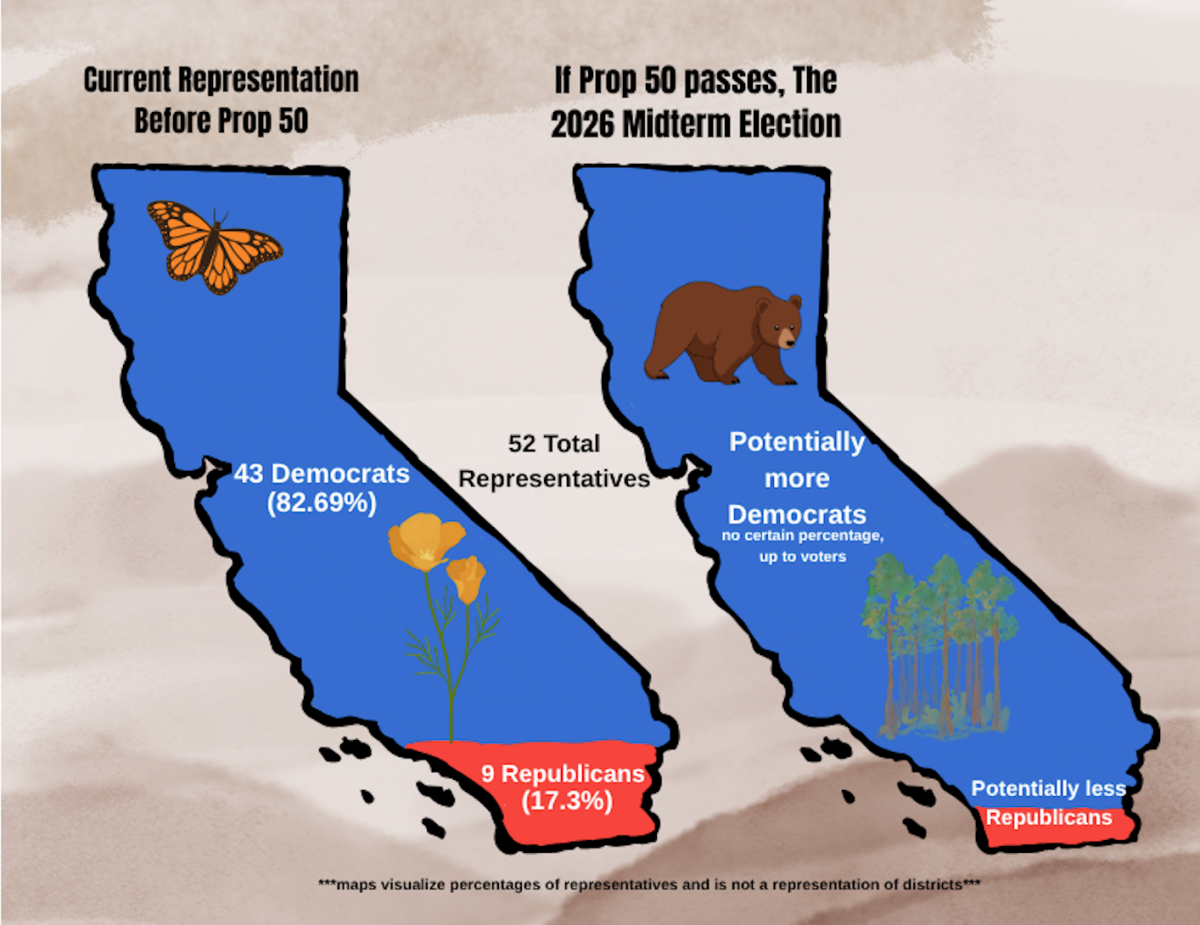
Graphic by Dylan Newman
Voters across the state will have the opportunity to decide on the future of congressional districts in California for the upcoming 2026, 2028 and 2030 election cycles with the introduction of Proposition 50, according to an Oct. 1 Los Angeles Times article.
California Governor Gavin Newsom is calling for the special election in order to give voters the option to decide whether or not to redraw congressional district maps to allow Democrats to take up to five new seats in the House of Representatives, according to an Aug. 21 press release from the Governor.
Newsom signed the “Election Rigging Response Act” in August, which places Prop 50 on the ballot as an answer to Republican-favoring gerrymandering in Texas and other Republican-led states, according to the same release.
Texas Governor Greg Abbott was encouraged by President Donald J. Trump in July to redraw the congressional maps of Texas in hopes of creating five new Republican seats that the president said the state was entitled to come the 2026 midterm elections, according to an Aug. 5 article published by Politico.
A “Yes” vote on Prop 50 grants California legislature the ability to implement a redrawn Congressional map in favor of democrats based on the 2024 election results, lasting until 2030, according to an article published by Ballotpedia.
“No” on 50 would uphold the current state congressional district map until the California Citizens Redistricting Commission redraws the map in 2031, according to the same article.
James Brent, a professor of political science at San José State, said that it’s unfortunate that Prop 50 is on the ballot because American politics has led to districts across the country already being gerrymandered to be either extremely democratic or extremely republican.
“Representatives who come from districts that are extremely tilted toward one party or the other rarely have to worry about losing their election,” Brent said. “So that means that they rarely have any incentive to cooperate or negotiate or compromise with the other political party.”
Gerrymandering is defined as dividing up political districts in favor of one party over the other, according to Merriam-Webster.
“I would say (college students being educated on Prop 50) is important for the same reason that it’s important that they be informed about any political issue,” Brent said. “Their vote, if they choose to cast one, will have a direct impact on the direction of this country for the next two years.”
The Spartan Daily reached out to SJSU Votes, a nonpartisan voter registration initiative at SJSU, but did not receive a response in time for publication.
Bill James, chair of the Santa Clara County Democratic Party, noted that Prop 50 is for the voters to decide, while the legislature is already gerrymandered, Texas had the power to change their districts without talking to the voters.
“There’s strong consensus that it’s the right thing to do to respond to what Trump did in Texas,” James said. “If Trump gets away with sort of changing the rules in the middle of the 10 year census cycle and to get more seats and have a bigger or create a bigger buffer for Democrats to overcome to take the house in 2026, then there’s no end to that.”
James also said that Prop 50 complies fully with the Voting Rights Act in terms of the distribution of groups such as Latinos within congressional districts.
The Voting Rights Act of 1965 was signed under then United States President Lyndon B. Johnson that enforces the 15th amendment to the U.S. Constitution, which prohibits denying people the right to vote based on race or color, according to the U.S. National Archives.
James said that there is only so much gerrymandering a state can do and that Prop 50 on the ballot is California fighting fire-with-fire.
David Johnson, chair of the Santa Clara County Republican Party who opposes Prop 50 explained that if the measure passes it will shrink Californian Republican representation in Congress, which stands at 17% of California’s representatives.
California’s representation across its 52 seats in the House of Representatives is made up of nine republicans and 43 democrats, according to another Ballotpedia webpage.
He said that this election will be challenged in court and that the state has wasted millions of dollars on issuing corrections to ballots.
“(Democrats) draw these squiggly lines to pick up more Democrat votes and therefore seats,” Johnson said. “This has been a standard practice — it’s not unique to California.”
He said that Prop 50 will put the California Citizens Redistricting Commission, whose purpose is to draw congressional maps, on hold.
The Citizens Redistricting Commission is a 14 member commission made up of five Republicans, five Democrats and four not affiliated with either of those parties, according to the organization’s website.
The commission was created by voters when the Voters FIRST Act was passed in 2008, which gave the responsibility of drawing congressional maps away from the California legislature to this commission in 2010, according to the same website.
Eight million voters of the state’s 13 million registered voter households received voter guides with inaccurate information, according to an Oct. 3 article published by NBC KCRA 3.
It will cost taxpayers at least two million dollars to issue correction postcards, according to the same source.
Supporting and opposing groups to Prop 50 have contributed around $84 million in donations, according to the California Fair Political Practices Commission.
In August, Trump threatened to sue California for Prop 50 and Republicans filed a complaint with California’s Supreme Court to attempt to remove the ballot measure, according to an Aug. 25 article from ABC7 Los Angeles.
The special election will be held on Nov. 4 and will include voting on measures within local city legislatures, according to a County of Santa Clara webpage.